The history of hand-brewed coffee | how did hand-brewed coffee become the darling of boutique coffee?
Professional coffee knowledge exchange more coffee bean information please follow the coffee workshop (Wechat official account cafe_style)
If you step into a boutique coffee shop, nine times out of ten there will be at least one hand coffee maker. If you think that hand-brewed coffee is something new, you may be wrong. In fact, V60 filter cups and Chemex handcups have been around for decades, but they are still typical of the third wave of coffee today.
But how did hand coffee evolve? Why can this simple brewing method become the darling of the boutique coffee trend? This article takes you to explore the history of hand-made coffee.
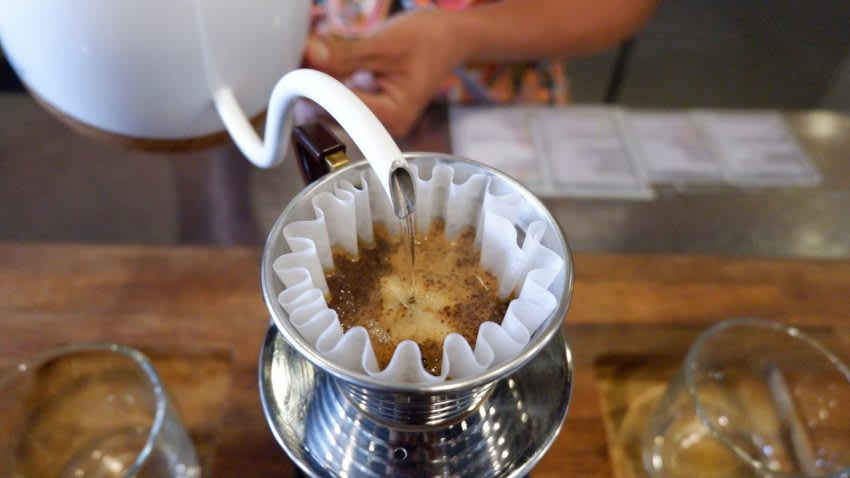
The source of everything.
For a hundred years, when people around the world made coffee, they poured ground coffee powder into pots and heated it with water, such as Saudi Arabia and Turkey. Around 1810, someone invented a coffee filtration pot in which hot water repeatedly passed through the coffee powder when it was used to make coffee. It was the most common way of cooking in Europe at that time. The espresso machine appeared immediately after.
But in the 20th century, German woman Melita Banzi was not satisfied with the taste of coffee brewed in a percolation pot and the coffee grounds in the cup, so she began to develop alternative brewing methods. She pokes a hole in the metal can with a nail and cooks the coffee with blotting paper. The finished coffee is less bitter than the coffee brewed in the percolation pot, and there is no coffee grounds to make trouble. In June 1908, Melita applied for a patent for the filter, and Melita was founded.
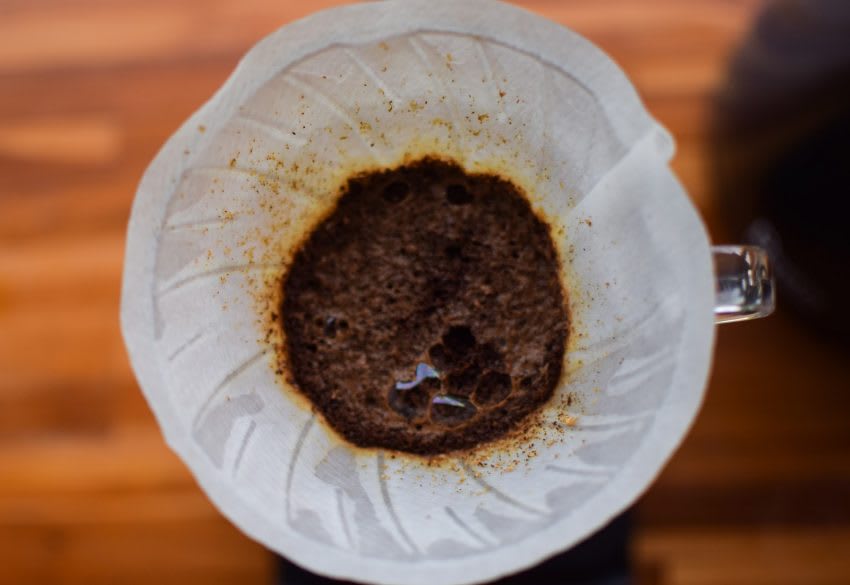
In 1909, Melita and her husband, Hugo, unveiled their filters at the Leipzig Trade Fair and were very popular. In the 1930s, Melita invented the conical filter cup, which is familiar to modern people. This design improved the quality of coffee products because the coffee extraction area became larger. Of course, they also invented devices that save more time and effort than metal cans and are used to support filter paper. They made a simple conical dripping device and placed it on the upper edge of the cup or pot. It is said that the first filter cup they sold had eight holes at the bottom, but in the 1960s it was changed to only one hole.
In the past, coffee filter cloth has been popular in Latin America for several years, but the invention and commercialization of filter paper has greatly changed the way we make coffee. Melita is now a global company with filter paper and cups in kitchens and cafes around the world.
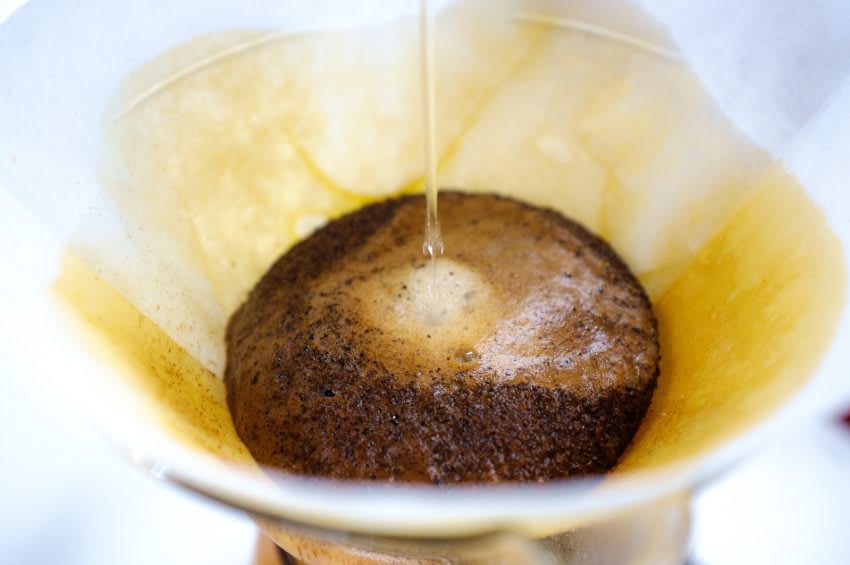
The evolution of hand-brewed coffee
Other people also invented all kinds of hand flushing and filtering devices, which came out at about the same time as Merita filter cup.
In 1941, German chemist Peter Schlumber invented the classic glass hand punching pot Chemex. Peter is said to have an eccentric personality dedicated to improving the efficiency and fun of everyday objects. He has applied for more than 300 patents, including cocktail bartenders and cars. Because of his specialty in chemistry, he was well aware of the way coffee was extracted and invented thick filter paper, which his partner said could make coffee less bitter, oil-free and residue-free.
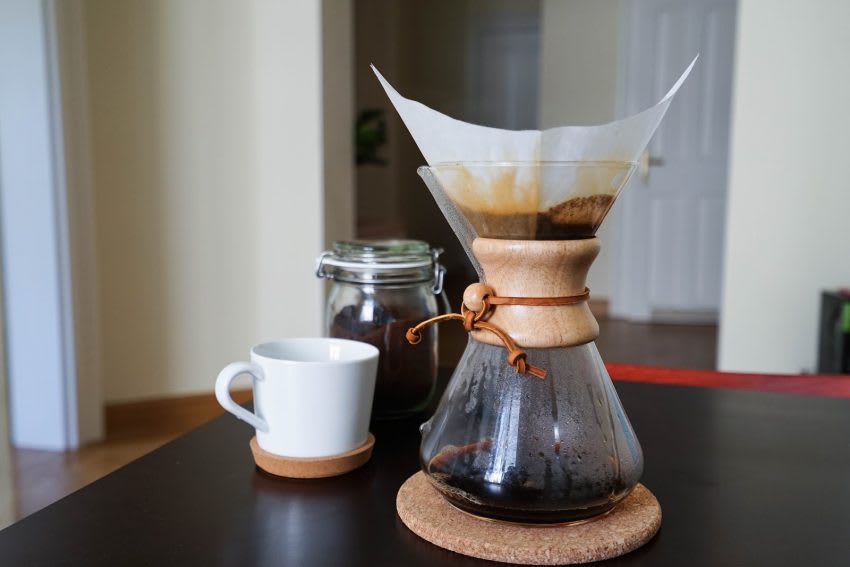
In 1959, people thought that this special hourglass-shaped coffee maker, Chemex, was one of the best inventions in modern times, and it also took practicality into account.
There is a circle of wood on the neck of the glass kettle, which makes it easy for the user to hold the hot pot, and the leather rope can prevent slippage. Glass pots are conceived from laboratory glassware to prevent them from absorbing odors or chemical residues and affecting the finished products that are cooked later.
In addition, there are many popular Japanese hand flushing devices. In 1921, Hario, a chemical glass equipment company, was founded in Tokyo. They invented the V60 filter cup to improve the filter support of the time.
Like other utensils, this conical filter cup is placed on the upper edge of the cup or glass pot to support the filter paper, but it is not that simple.
The taper of this filter cup is 60 °, so the water will flow to the center of the coffee powder, prolonging the contact time of the powder. It also has a large hole that reduces coffee filtering time, while other similar appliances have only a few small holes. The V60 filter cup also has spiral grooves to circulate the air, thus allowing the coffee powder to expand as much as possible.
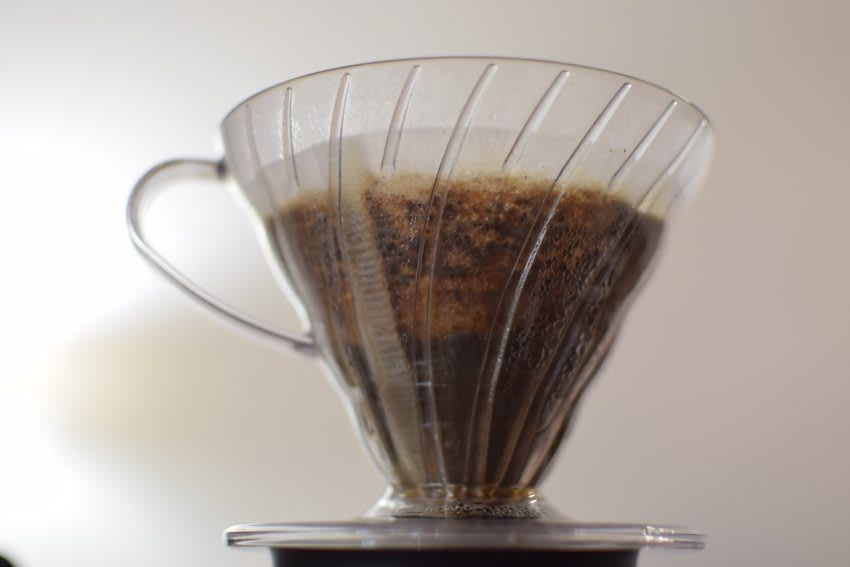
The Kalita Wave filter cup is also invented in Japan and is characterized by a flat bottom with three holes that can derive all the water from the coffee powder and make the coffee fresh. It is also designed to minimize the contact between the filter cup and the filter paper, so that the water temperature is consistent and the water is uniformly dispersed.
Filter paper is not the only choice for hand-brewed coffee. Costa Rica has a method called "chorreador", which uses wood brackets and filter cloth to cook, which has been in practice for years before Melita stuffed blotting paper into metal cans. The filter cloth can be reused and produces less garbage than filter paper. Coffee filter cloth is also a choice of fine coffee.
Hand flushing in the tide of boutique coffee
Chemex hand pots and other hand-brewing appliances became popular in the middle of the last century, but most of them have gone out of fashion and have only been revived by boutique coffee promoters in recent years.
Coffee makers and espresso machines are the protagonists of the second wave of coffee, but in the third wave, people begin to pay attention to details and want to know more about the causes of brewing. Coffee lovers also want fresh coffee, not coffee that has been brewed and left on the thermostat for hours.
Baristas pour water into coffee powder by hand, which makes it easier to control the contact of coffee powder than an automatic coffee drip filter. Baristas control extraction to prevent coffee from being too bitter or too light. In addition, hand brewing can make coffee with a clean flavor, so it is respected, unlike coffee extracted by soaking (such as a French kettle), which has a strong flavor.
Dave, project manager of Grumpy Mule, a baking company based in Homvers, UK, and champion of British coffee blending in 2014 and 2016, shared: "over the years, the public has been deeply influenced by high concentrations of coffee and over-extracted deep-roasted coffee, and it has to be changed step by step before they can go back to filtered hand-brewed coffee."
"the third wave of coffee advocates hand brewing, because manual brewing has brought back the quality of filtered coffee, and the public has once again begun to enjoy high-quality black coffee."
Boutique coffee lovers also have a love of admiration. Daniel, Managing Director of Caf é Batalla, San Jose, Costa Rica, shared: "hand flushing not only attracts attention, but also brings complex flavor and smell to coffee. Even consumers who are not familiar with coffee can be fascinated by this simple brewing method. "
He then said: "hand-brewed coffee has been very popular in recent years. I think on the one hand, there is a rise in consumer awareness, and on the other hand, the public is flocking to handicrafts."
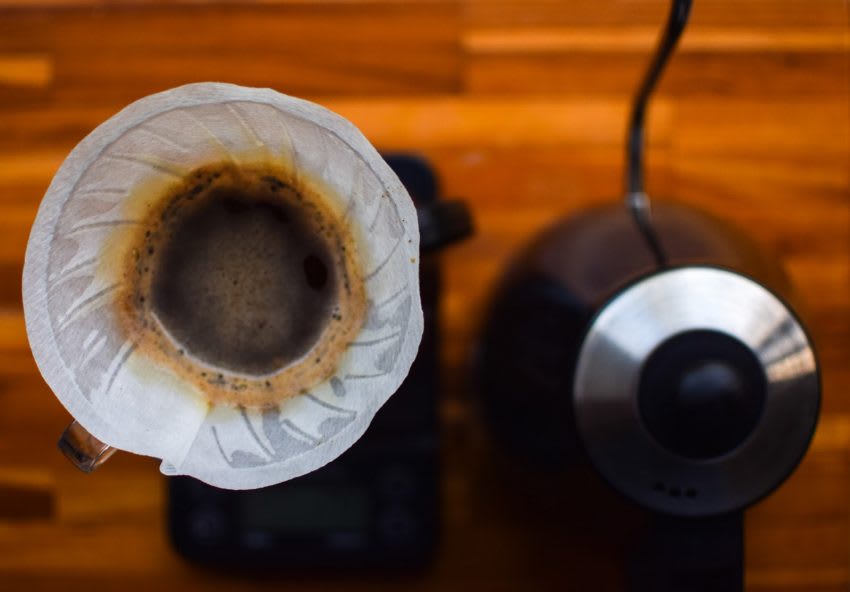
Of course, the detail skill of hand flushing is one of its bright spots. One of the demands of the third wave of coffee is hand brewing, which is similar to the recovery of craft beer and sour bread, because it emphasizes the subtle integration of skills. People who think they are coffee fans also have such persistence in their love.
Hand baristas need to understand "pulse pouring" and "agitation" before they can brew high-quality coffee. in addition, they also need to clearly understand the factors that affect the extraction, such as grinding particle size, cloth powder filling height, water temperature and so on. Also, are you familiar with Miyazhe's "four or six flushing method"?
The World Cup Coffee Brewing Competition emphasizes this kind of research attitude, and shows that: "the key point of hand brewing is the skill of brewing coffee with pure manpower."
In 2006, Starbucks' single-item coffee machine, the Clover, was launched and introduced to certain stores. Starbucks said it used "complete immersion and vacuum extraction, with the skills of our baristas, to bring out the complete flavor of our selected coffee, one cup at a time."
Jonathan Bonchak, associate business officer at slingshot Coffee, says this has prompted more consumers to pursue a single cup of coffee. "after coffee machines dominate the market, coffee consumers like the 'cup-by-cup' way of buying and selling and want to know more about brewing," he said. "
The sound of opposition to hand-made coffee
However, manual brewing and heavy water injection skills, human carelessness may make a cup of coffee insufficient extraction. For example, poor water injection may cause a "channelling", in which case the water flows down from the smooth place of the powder, so that some coffee powder is not extracted.
The more factors of control, the more likely it is to make mistakes, and the more difficult it is to be consistent with the finished products, so there is a wave of opposition to the hand-punching method.
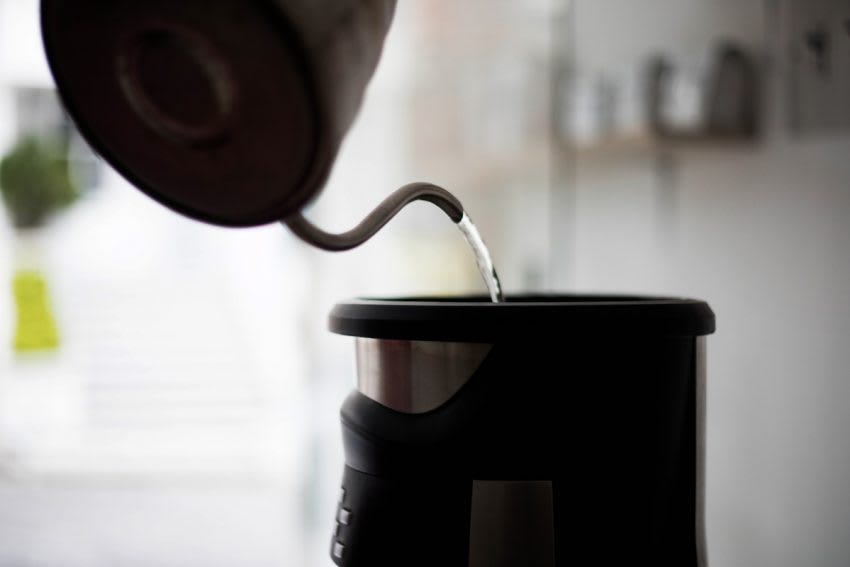
But some criticisms of the "hand punch" are untenable. If handled properly, this cooking method is even better than the hand-flushing method, because it is more stable when injecting water into powder. There is a SCA (boutique coffee association) certified hand machine, reduce the uncertainty of human error, but also ensure the high quality of the finished product.
Dave points out: "History really repeats itself, and the early hand promoters are now leading the way for the public to accept high-quality hand-brewed coffee, both high-quality beans and the right powder-to-water ratio, because the finished coffee is more stable and cost-effective."
So there is a reason why hand-brewed coffee has been so popular in recent years: not only does the finished product have a clean flavor and a low price, but it also gives baristas complete control over variables. If you want to know more about coffee, this is a great starting point.
But the hand depends on the basic understanding of extraction, if you ignore the grinding thickness, do not learn how to inject water, it is easy to make bad coffee. Even a seasoned barista cannot brew exactly the same coffee every time. Routine homework is one of the attractions of hand brewing, but if you want the finished product to be stable, you can study a SCA-certified coffee maker or order a cup of hand coffee at a coffee shop near your home.
Original author: Hazel Boydell
Original source: Perfect Daily Grind
END
Important Notice :
前街咖啡 FrontStreet Coffee has moved to new addredd:
FrontStreet Coffee Address: 315,Donghua East Road,GuangZhou
Tel:020 38364473
- Prev

How does a coffee cup affect the flavor of coffee? Choosing the right cup is important for coffee!
A good cup of coffee is worth tasting carefully. When you pick up a coffee cup or glass to drink, you will first smell the aroma of coffee, followed by a satisfying taste. The remaining charm in the mouth is to choose mugs and glasses. Different shape, size, mouth thickness and material will affect your feeling of tasting coffee, and there may be points for aroma and flavor, or deduction points.
- Next

Where did American coffee come from? The story behind American coffee
Professional coffee knowledge exchange more coffee bean information please follow the coffee workshop (Wechat official account cafe_style) if you are in Australia, order a cup of long black coffee (Long Black). In some states of the United States, they order espresso (Italiano). But in most parts of the world, this coffee is called American coffee (America), and American coffee is the world.
Related
- Beginners will see the "Coffee pull flower" guide!
- What is the difference between ice blog purified milk and ordinary milk coffee?
- Why is the Philippines the largest producer of crops in Liberia?
- For coffee extraction, should the fine powder be retained?
- How does extracted espresso fill pressed powder? How much strength does it take to press the powder?
- How to make jasmine cold extract coffee? Is the jasmine + latte good?
- Will this little toy really make the coffee taste better? How does Lily Drip affect coffee extraction?
- Will the action of slapping the filter cup also affect coffee extraction?
- What's the difference between powder-to-water ratio and powder-to-liquid ratio?
- What is the Ethiopian local species? What does it have to do with Heirloom native species?

